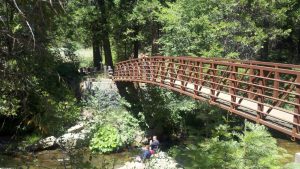Imagine pulling into a parking lot to notice a group of people intensely staring at the ground. As crazy as it seems, they are watching an egg fry on the concrete. Alright, that may not be happening, but we can all agree that it has been egg-frying hot with little relief at times this summer.
Historically, California was a desert that miraculously changed due to location and irrigation. Without our winter snows and fertile soils, we are like any other place in the Southwest with those cacti that look like they are being held up, both hands to the sky. That group of egg fryers may be talking about climate change, global warming, or the best frying eggs. Let’s add to the conversation with an answer that can help us all.
The answer is a partnership. We breathe out, they breathe in. Our exhaled carbon dioxide provides trees and plants with life, while the oxygen they produce benefits us. A hearty thanks to photosynthesis that keeps us all breathing. Trees absorb carbon dioxide and water, then add energy from light to produce carbohydrates (food), with oxygen for us. Trees use some carbs for the processes of living, then store the rest.
There is a carbon storage measurement standard called the Life Cycle Assessment (LCA). Researchers have discovered by using LCA that forest and wood products have the greatest potential to reduce climate problems.
City trees are hard-working, providing shade in parking lots while living in small areas of dirt. Trees make afternoon strolls on neighborhood sidewalks cool and comfortable. With strategic planting, trees help control energy costs and usage. Heat islands are formed when urban areas lack trees. Since temperatures are significantly higher in heat islands, trees are as important as other city infrastructure. Trees cool our cities, stabilize our soil during weather events, beautify parks and homes, drive foot traffic to businesses, block unsightly views, and contain noise—all highly desirable benefits.
Our trees also act as history markers, being alive for particular events in time. There are trees that are immediately recognizable, like the Lone Cypress at Pebble Beach which has been photographed since the 1880’s. Our large oak trees have been here since Black Bart robbed the stage from the gold fields.
The tree side of the ledger is heavily weighted in favor of trees. What is our responsibility? When you choose a tree, you are planting a future, so choose your landscape tree carefully. It must be adaptable to your area and major branches should not be limited to two in a “V” shape, which creates a weak union. If it is to provide shade, its “head,” with the leaves and branches, should sit higher on a longer trunk, allowing room underneath to sit or walk. Trees need to be observed for problems, maintained, and correctly planted. Think of a new tree as a new member of your family that will provide your loved ones with comfort and well-being.
Leave your eggs in the fridge. Let’s plant some shade, take a deep breath, and add to our family for decades to come.
Julie Silva is a University of California Cooperative Extension Master Gardener of Tuolumne County.

